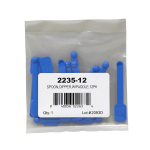I never got an answer from Taylor about that one fluky series of FAS-DPD FC tests I encountered back in March. It is now the only chlorine test I do unless I am demonstrating the straight-up DPD method to one of my lifeguards. I love having a confidence level in my results give or take 0.2 ppm.
I am less enthralled by that tiny little blue spoon and the way it interacts with the DPD powder. It cakes up on the spoon making any kind of precise measurement dubious. Then it hangs around and turns the spoon and the little plastic powder container it hangs on black. Cleaning the spoon, even with water or alcohol and a Q-tip, leaves most of the smut in place. It probably does not matter but it bugs me so I wasted a good part of this stormy Independence Day looking for Taylor spoon alternatives.
First question that came up is what does 50 mg of DPD powder equate to in terms of volume? One 32nd of a teaspoon? 1/64? My nasty little blue spoon holds between 50 and 60 mg of water so that would be between 1/83rd and 1/100th of a level teaspoon if my tiny scale is accurate and I got my math right.
Second question was—does powder precision mater? the instructions state "Add 2 dippers R-0870 DPD Powder. Swirl until dissolved. Sample will turn pink (Fig. 1) if free chlorine is present. NOTE: If pink color disappears, add R-0870 DPD Powder until color turns pink." Given the nature of the dipper and the powder "2 dippers" could vary a lot from one person to the next. I find that, if FC is even only 1 PPM, I get a pretty bright pink with just two dippers. If you can just continue to shovel the stuff in . . . how much can precision matter? If it doesn't matter much or at all, can I just use the tip of a popsicle stick to dump a little in? If it doesn't turn pink, just keep doing it until it does?
Possible solutions I have found to my nasty little spoon problem include: tiny stainless measuring spoons, tiny disposable plastic measuring spoons, a 12 pack of the little blue Taylor spoons, and popsicle sticks which are biodegradable and cheap as dirt. I could also see a shrink but that would be prohibitively expensive.
I am less enthralled by that tiny little blue spoon and the way it interacts with the DPD powder. It cakes up on the spoon making any kind of precise measurement dubious. Then it hangs around and turns the spoon and the little plastic powder container it hangs on black. Cleaning the spoon, even with water or alcohol and a Q-tip, leaves most of the smut in place. It probably does not matter but it bugs me so I wasted a good part of this stormy Independence Day looking for Taylor spoon alternatives.
First question that came up is what does 50 mg of DPD powder equate to in terms of volume? One 32nd of a teaspoon? 1/64? My nasty little blue spoon holds between 50 and 60 mg of water so that would be between 1/83rd and 1/100th of a level teaspoon if my tiny scale is accurate and I got my math right.
Second question was—does powder precision mater? the instructions state "Add 2 dippers R-0870 DPD Powder. Swirl until dissolved. Sample will turn pink (Fig. 1) if free chlorine is present. NOTE: If pink color disappears, add R-0870 DPD Powder until color turns pink." Given the nature of the dipper and the powder "2 dippers" could vary a lot from one person to the next. I find that, if FC is even only 1 PPM, I get a pretty bright pink with just two dippers. If you can just continue to shovel the stuff in . . . how much can precision matter? If it doesn't matter much or at all, can I just use the tip of a popsicle stick to dump a little in? If it doesn't turn pink, just keep doing it until it does?
Possible solutions I have found to my nasty little spoon problem include: tiny stainless measuring spoons, tiny disposable plastic measuring spoons, a 12 pack of the little blue Taylor spoons, and popsicle sticks which are biodegradable and cheap as dirt. I could also see a shrink but that would be prohibitively expensive.
Last edited:


